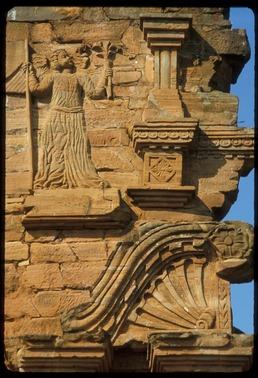Subproject 2: The Jesuit Reductions in Paraquaria
(Dr. des. Amrei Buchholz)
Subproject 2, like Subproject 1, is devoted to examples of new visual dispositifs in the Early Modern Period. It analyses order-specific characteristics of art production in the former Jesuit province of Paraquaria (1604–1767/68), a geographical area that today includes Paraguay and parts of all its neighbouring states. The aim is to investigate transcultural processes of negotiation between the indigenous Guaraní people and the Jesuits on the basis of art production in the Paraquarian Jesuit reductions. In addition to sculpture, which was produced on a large scale by the Guaraní themselves under the direction of the Jesuit fathers, the project also focuses on the architecture of the Jesuit missions, which we shall interrogate not only as a visual programme but also as a setting in which transcultural exchange took place. The project looks thirdly at the medium of cartography, into whose representation of space indigenous as well as Jesuit geographical knowledge was inscribed and – due to the traditional practice of copying maps – perpetuated over a long period.
The translation processes that can be identified for the Jesuit province of Paraquaria confirm that visual systems are not static, but rather that new iconographies and new conceptions of visuality are constantly being generated in processes of negotiation between various actors. The goal of this study is therefore to sketch the emergence of transcultural imagination and the genesis of colonial visual cultures and to show that these visual cultures can no longer be broken down into individual, essentialized subsystems (one European-Christian, one Pre-Hispanic), since the mixing and interweaving result in something that is more than the sum of its parts. Against this backdrop, the project considers how the visual types traditional to one group were taken up by other participants in colonial society and then read and reprocessed in accordance with their own experience of representation and their perspective on the colonial reality. This issue assumes particular relevance for Subproject 2 given that the Guaraní had produced no figurative or mimetic art of their own prior to the arrival of the Jesuits. In order to establish an art-historical framework for image production by the Paraquarian missions, this means looking for new categories of description for the self-showing, whereby both a specific object presence and its deictic potential are addressed.


